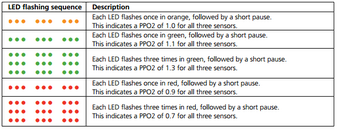but the rebreather is only controlling one thing. All the rebreather has to do is know the target mV level of the O2 sensors, monitor them to know what they are at, and decide to fire a solenoid to adjust the mV levels. It determines this level from two inputs, the ambient pressure sensor, and the O2 cells. That's the only control it has, and only one it needs because there is nothing else for it to do. CO2 sensor, all that is is an if/then statement for a threshold and if it meets or exceeds, it fires a warning, and it may give real time output levels, pretty easy. Temp stick, same thing, monitors and outputs the value, but neither of those effect the fundamentals of the system.
If mV of cells is low, fire solenoid until desired mV value is reached. Desired mV value is determined by user input PO2 value, calculated by mV value from cells with the pressure reading from the depth sensor. Desired PO2=user input value. Actual PO2=mV*pressure
Once desired mV value is reached, stop firing until it gets below threshold. Diver should have manual add button and be able to disengage the solenoid in event of an emergency, but you can't compare this to the ECU in your car, or the avionics and engine management in an airplane. They are orders of magnitude more complex. This is the type of stuff that spooks people and makes them not trust the computer. You can choose to not trust it on deco algorithms, fine. You can choose to not trust the temp stick or the CO2 sensor, fine. Not trusting a simple circuits ability to read a voltage level on an O2 sensor, not fine. Not trusting the O2 sensors themselves, shouldn't be diving a rebreather, or nitrox, or anything but air.
Not trusting a very simple coding structure of measure two values, multiple them together, and if that value is not the target, fire the solenoid to adjust is ridiculous. This is one of the most simple machines out there. APD and Shearwater have decided to make them more reliable by removing as much analog transmitting as possible and replacing it with digital. Actual current going across long skinny wires in a bundle across connections is not reliable. 0/1's going down fewer thicker wires is perfectly OK regardless of how many connections because the computers can diagnose the signal and know if it is right or not.
Summary, if you don't trust the rebreather to fire a damned solenoid, you better be the same guys still diving tables and bottom timers and refusing to trust computers because if you aren't you are just being ignorant and hypocritical. It is literally that simple, and I apologize if that offends anyone, but no human can drive a rebreather as accurately as the computers can, it's not possible. I'm not aware of any recent incidents *since the Vision electronics and DiveCan's came out* where the computers were the cause of the accident. It was either O2 sensors, or the idiot diving it. The digital systems remove a little bit of the unreliability to the O2 sensors because now their monitored values can't be wrong. Their readings may be wrong, but the computer will always know exactly what the sensor is reading instead of running the risk of interference/voltage drop over connections etc. That alone is a huge step forward in their safety/reliability because the computers are now always aware of the ACTUAL readings at the cells. Again, those readings may not be accurate, but at least you can trust that the computers are always spitting out the actual values or no values at all. I'd rather have a computer just say "nope, sorry, can't get the signal, I have no idea what the hell is going on, bail out", then start to give me flaky numbers or wrong numbers.





